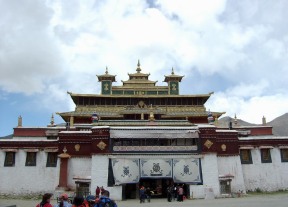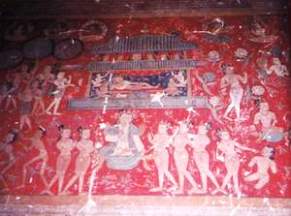The Shalu Monastery is located 20 kilometers (12 miles) south of Shigatse. Chetsun Sherab Jungnay founded the monastery in 1040. The story of its founding involves Chetsun and his teacher. His teacher suggested that Chetsun shoot an arrow, and found a monastery where the arrow hit. The flying arrow hit a new bud. The monastery was named  Shalu, meaning "new bud" in Tibetan. Shalu, meaning "new bud" in Tibetan.
In 1320, Buton Rinpoche became abbot of the monastery. Buton was one of the greatest religious scholars of his time. His knowledge covered a wide range of religious subjects. So did the library that he assembled. He brought together 108 volumes of the fundamental texts of Buddhism, including the Kanjur and Tenjur sutras, plus 200 volumes of "treaties and commentaries". Over 3,000 monks were attracted to his teachings. Because he had no interest in politics, however, his sect was not politically very influential.
Shalupa, also known as Butonpa, took form under Buton's leadership. Shalupa included magical feats that monks learned to do. Some monks wore thin clothing in cold weather. They were able to raise their body temperatures to such a level that warm clothing was not needed. Other monks were able to run by leaping superhuman distances. covering long distances without rest.
The monastery is architecturally distinctive. In 1329, an earthquake destroyed the monastery. In 1333, Buton rebuilt it under the patronage of the Chinese Mongolian emperor. Since many Chinese Han artisans participated in rebuilding the monastery, combining the local Tibetan style with that of Chinese Yuan Dynasty.
Shalu Lakhang is the central hall of the monastery with Other buildings of the monastery surrounded it. On the ground  floor, the Tschomchen (also a hall) enshrines Sakyamuni and his disciples. Sakyamuni was one of the Buddhas. The chapels flanking the Tschomchen house Tanjur and Kanjur, two very important sutras of Tibetan Buddhism. Chapels in the roof floor are of typical Chinese blue tile design. The chapels enshrine Sakyamuni, Shalu Monastery's own Buton, and the Arhats. Arhats are those who have attained enlightenment, but whose rank and power is lower than that of a Buddha. Massive, delicately painted murals cover the walls of the monastery. Most of the murals depict stories from the life of the Buddha. The murals badly need restoration to preserve and protect them. floor, the Tschomchen (also a hall) enshrines Sakyamuni and his disciples. Sakyamuni was one of the Buddhas. The chapels flanking the Tschomchen house Tanjur and Kanjur, two very important sutras of Tibetan Buddhism. Chapels in the roof floor are of typical Chinese blue tile design. The chapels enshrine Sakyamuni, Shalu Monastery's own Buton, and the Arhats. Arhats are those who have attained enlightenment, but whose rank and power is lower than that of a Buddha. Massive, delicately painted murals cover the walls of the monastery. Most of the murals depict stories from the life of the Buddha. The murals badly need restoration to preserve and protect them.
Shalu Monastery has four religious treasures. One is a sutra board, which is 700 years old and impossible to be reassembled if it is ever broken apart. A passage of sutra is printed on the board and is believed to bring good luck. The second treasure is a brass urn. It contains holy water that can cleanse away the 108 filths of human existence. The urn is usually sealed and covered with red cloth. The water is changed every 12 years. The third treasure is a stone basin that was once Chetsun Sherab Jungnay's washbasin. The fourth treasure is a stone tablet on which the mantra "om mani Padme Hum" is written and four dagobas are carved. It was discovered during the original construction of the monastery. |
